Horizon Hobby RVOF1100 Ascent MTx User Manual 2 of 3
Horizon Hobby, LLC Ascent MTx 2 of 3
Contents
- 1. User Manual 1 of 3
- 2. User Manual 2 of 3
- 3. User Manual 3 of 3
User Manual 2 of 3
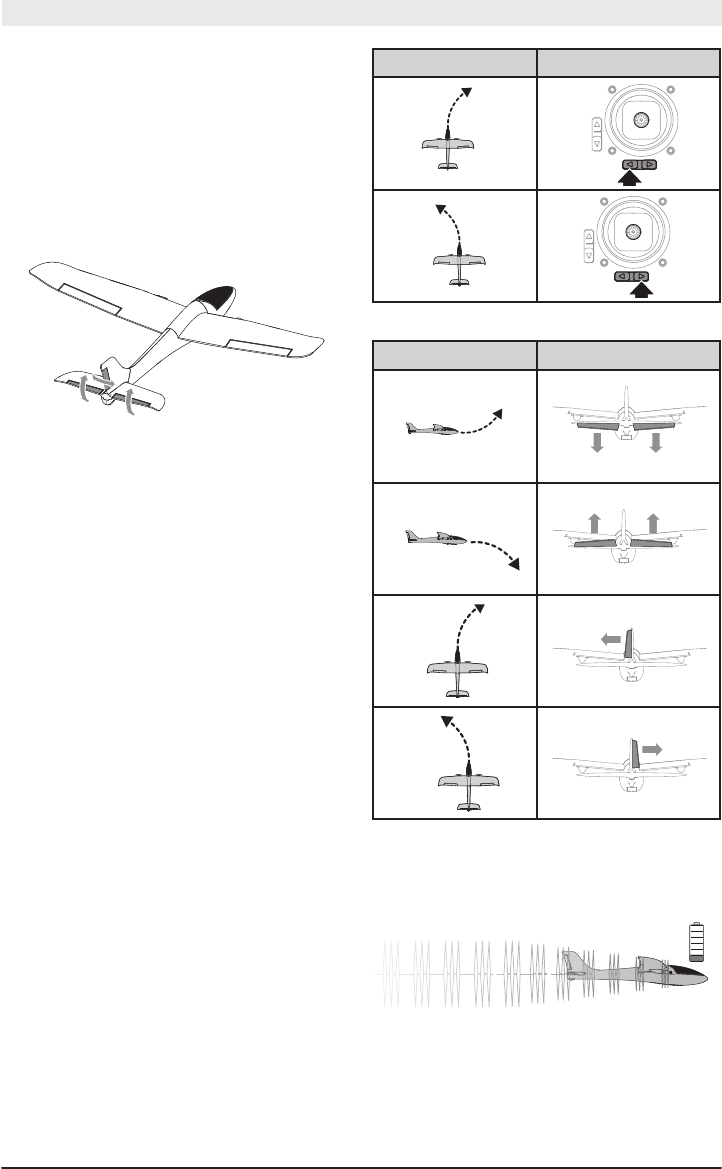
EN
8
When you notice any reduction of power or 10
minuets have elapsed, immediately land the aircraft
and recharge the battery.
If the aircraft’s nose drifts left or right while the
steering stick is at neutral (centered) press the
steering trim buttons as shown in the chart to the
right to correct the drift.
The Ascent MTx can also be trimmed by carefully
bending the control surfaces molded into the tail as
shown below.
1. Center the transmitter trims.
2. Carefully bend the control surface in the direction
shown in the chart to the right.
Only make small adjustments to the control
surfaces. Avoid making large changes as this could
affect ight performance.
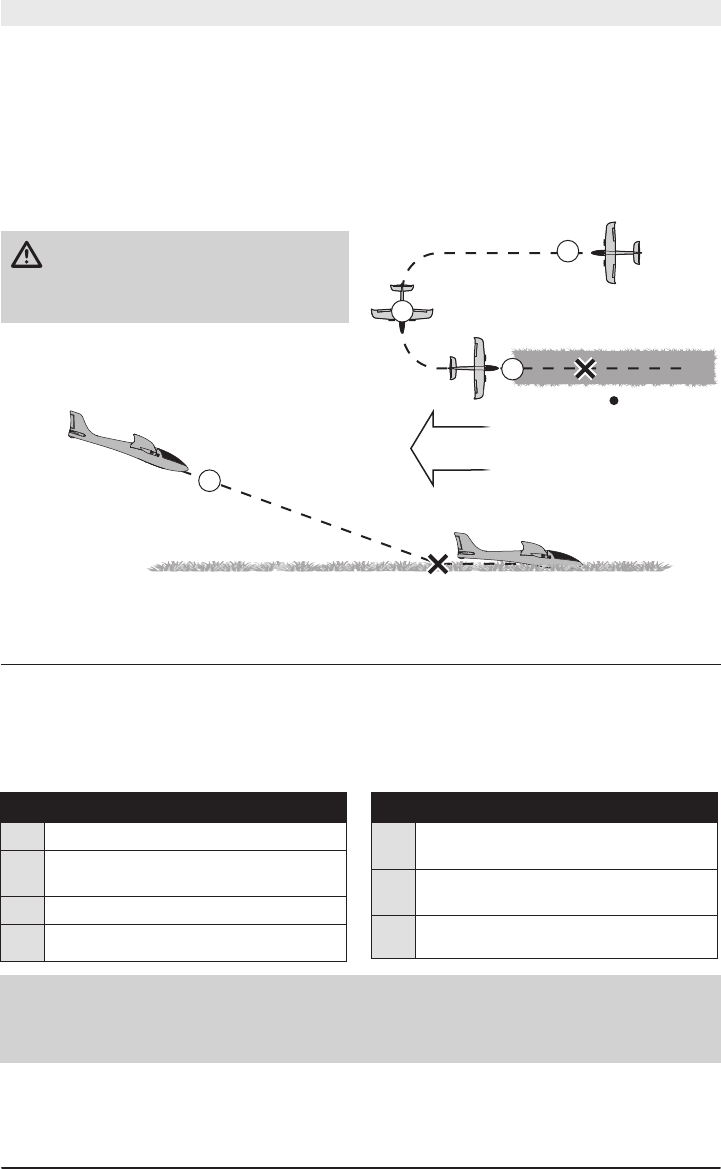
EN
9
1. Fly downwind and reduce the throttle to 25% to begin the descent.
2. Begin turning towards the runway, heading into the wind.
3. Reduce the throttle to 0% and glide onto the runway.
• If you are going to land short of the runway, add a little throttle to extend the glide.
• If you are going too fast to land, go around and try again.
Never catch a ying aircraft in
your hands. Doing so could cause personal injury
and damage to the aircraft.
2
3
3
Wind 0–5 mph
(0–8 km/h)
Pilot
1. Lower throttle to 0%
2. Disconnect and remove the ight
battery
3. Power off the transmitter
4. Fully charge the ight battery
5. After charging is complete, remove
the battery and store in a safe place
6. Inspect airframe and make any
repairs
7. Store in the original product box
When you are nished ying, never
leave the aircraft in direct sunlight or in a hot,
enclosed area such as a car. Doing so can
damage the foam.
Always disconnect the battery from the
aircraft before powering off the transmitter or
injury and damage may result.
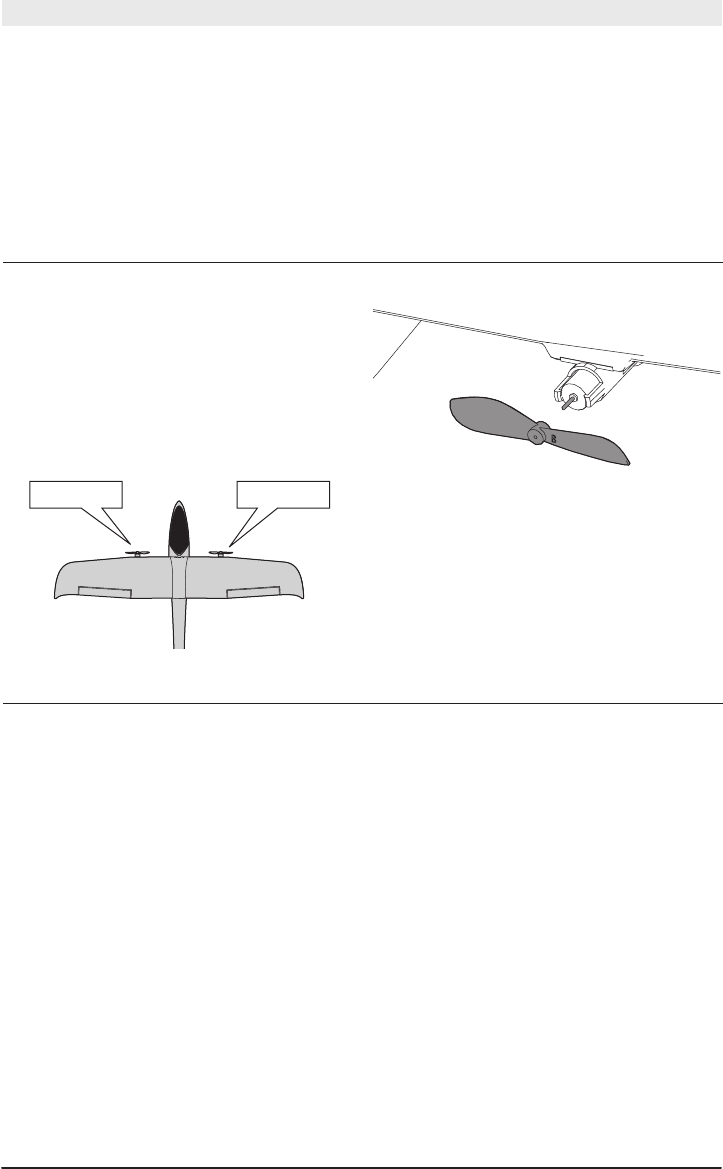
EN
10
Repairs to the foam can be made using virtually any adhesive (hot glue, regular CA (cyanoacrylate adhesive),
epoxy or tape).
1. For small tears, use CA to bond the break
2. When parts are not repairable, see the Replacement Parts List for ordering by item number. For a listing
of all replacement and optional parts, refer to the list at the back of this manual.
1. Remove the propeller (A) from the motor shaft ().
2. Carefully allign the new propeller on the motor
shaft and rmly press into place.
The propellers must be installed with
the propeller marked with an A on the right and B
on the left. See illustration below.
If your aircraft does not respond to the transmitter when the batteries in the aircraft and transmitter are fully
charged, bind your aircraft and transmitter by using the instructions below.
1. Turn off the aircraft by rst disconnecting the ight battery from the aircraft and then powering off the
transmitter.
2. Make sure your transmitter’s controls are neutral, and the throttle is in the off position (0%).
3. Power on the transmitter. The red LED will start ashing indicating the transmitter is in Bind mode.
4. Connect the ight battery to the aircraft and move the switch to the on position.
5. Hold the transmitter more than 24 inches (60 cm) away from the aircraft. Keep away from large metal
objects, wireless sources and other transmitters.
6. Move the throttle stick from power off (0%) to full throttle (100%) and back to power off. The red LED will
change from ashing to solid when the Bind is complete.
7. Once the Bind is complete you will have control of the motors with the throttle and steering stick.
A
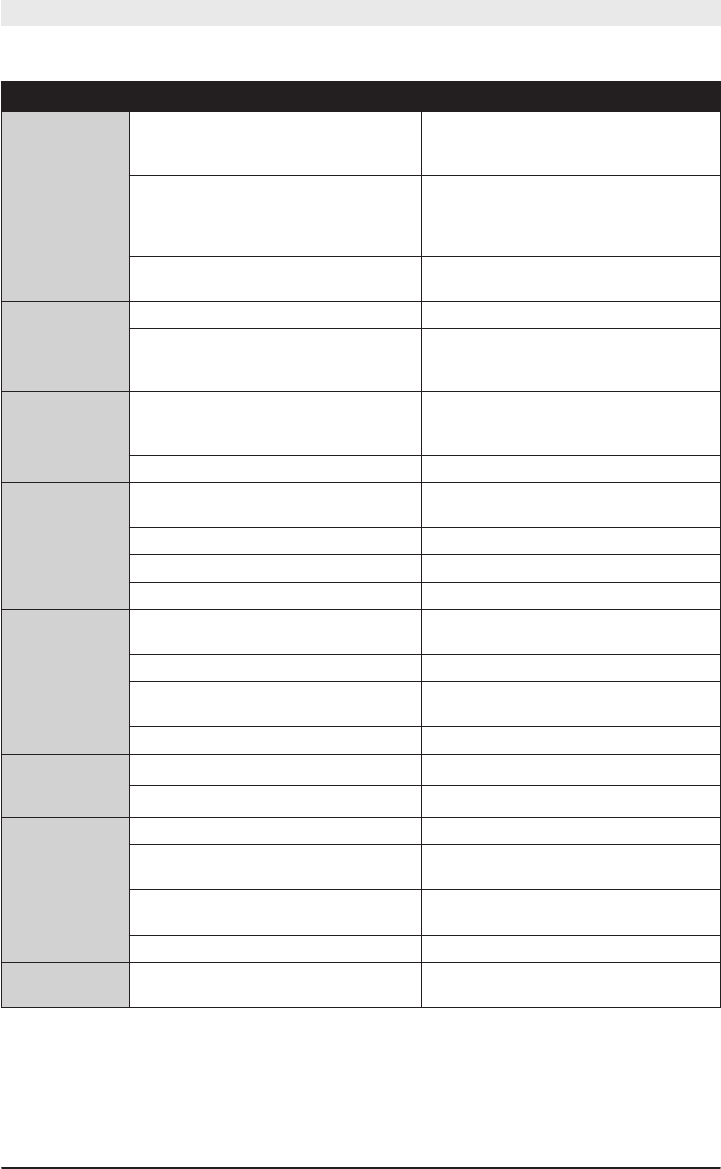
EN
11
Solution
Aircraft does not
respond to the
transmitter
No connection Follow Binding Instructions. Follow
“Installing the Flight Battery” instructions.
Replace or recharge batteries
Transmitter too near the aircraft or both
are too near large metal objects, wireless
sources or another transmitter during
battery connection or Binding
Move to another location, with the trans-
mitter more than 24 inches (60 cm) from
the aircraft and attempt battery connec-
tion or Binding again
Low or no power Replace or recharge batteries and cor-
rectly connect the aircraft battery
Poor aircraft
response to the
transmitter
Poor radio connection Replace or recharge batteries
Poor control adjustment or damage to the
aircraft Adjust steering by using left or right trim
buttons or land immediately and adjust,
repair or replace parts
Aircraft turns in
one direction Poor control adjustment or damage to the
aircraft Adjust steering by using the left or right
trim buttons or land immediately and
adjust, repair or replace parts
Wind is too gusty or strong Fly on a calmer day
Aircraft rises
steeply at half
throttle
Poor control adjustment or damage to the
aircraft Use less throttle to y without climbing
Elevator is trimmed for a climb Flex elevator down slightly
Aircraft battery is incorrectly installed Install aircraft battery fully back
Wind is too gusty or strong Fly on a calmer day
Aircraft will not
climb Poor control adjustment or damage to the
aircraft Increase throttle making the airplane y
faster and climb
Elevator is trimmed for a descent Flex elevator up slightly
Propellers or spinners are loose or dam-
aged Land immediately and adjust, repair or
replace parts
Low or no power Replace or recharge batteries
Aircraft is dif-
cult to launch
in the wind
Gusty or cross winds Launch directly into the wind
Wind speed is too fast for safe ight Fly on a calmer day
Flight time is too
short Battery is not fully charged or is damaged Recharge or replace the battery
Propellers are loose or damaged Land immediately and adjust, repair or
replace parts
Flying at full throttle during entire ight Fly at just above half throttle to increase
ying time
Wind speed is too fast for safe ight Fly on a calmer day
Aircraft vibrates Propellers or spinners are loose or dam-
aged Land immediately and adjust, repair or
replace parts

EN
12
Horizon Hobby, LLC, (Horizon) warrants to the original
purchaser that the product purchased (the “Product”) will be
free from defects in materials and workmanship at the date
of purchase.
This warranty is not transferable and does not cover (i)
cosmetic damage, (ii) damage due to acts of God, accident,
misuse, abuse, negligence, commercial use, or due to
improper use, installation, operation or maintenance, (iii)
modication of or to any part of the Product, (iv) attempted
service by anyone other than a Horizon Hobby authorized
service center, (v) Product not purchased from an authorized
Horizon dealer, or (vi) Product not compliant with applicable
technical regulations, or (vii) use that violates any applicable
laws, rules, or regulations.
OTHER THAN THE EXPRESS WARRANTY ABOVE, HORIZON
MAKES NO OTHER WARRANTY OR REPRESENTATION, AND
HEREBY DISCLAIMS ANY AND ALL IMPLIED WARRANTIES,
INCLUDING, WITHOUT LIMITATION, THE IMPLIED
WARRANTIES OF NON-INFRINGEMENT, MERCHANTABILITY
AND FITNESS FOR A PARTICULAR PURPOSE. THE
PURCHASER ACKNOWLEDGES THAT THEY ALONE HAVE
DETERMINED THAT THE PRODUCT WILL SUITABLY MEET THE
REQUIREMENTS OF THE PURCHASER’S INTENDED USE.
Horizon’s sole obligation and purchaser’s sole and exclusive
remedy shall be that Horizon will, at its option, either (i)
service, or (ii) replace, any Product determined by Horizon to
be defective.
Horizon reserves the right to inspect any and all Product(s)
involved in a warranty claim. Service or replacement
decisions are at the sole discretion of Horizon. Proof of
purchase is required for all warranty claims. SERVICE OR
REPLACEMENT AS PROVIDED UNDER THIS WARRANTY IS
THE PURCHASER’S SOLE AND EXCLUSIVE REMEDY.
HORIZON SHALL NOT BE LIABLE FOR SPECIAL, INDIRECT,
INCIDENTAL OR CONSEQUENTIAL DAMAGES, LOSS OF
PROFITS OR PRODUCTION OR COMMERCIAL LOSS IN ANY
WAY, REGARDLESS OF WHETHER SUCH CLAIM IS BASED
IN CONTRACT, WARRANTY, TORT, NEGLIGENCE, STRICT
LIABILITY OR ANY OTHER THEORY OF LIABILITY, EVEN IF
HORIZON HAS BEEN ADVISED OF THE POSSIBILITY OF SUCH
DAMAGES. Further, in no event shall the liability of Horizon
exceed the individual price of the Product on which liability
is asserted. As Horizon has no control over use, setup,
nal assembly, modication or misuse, no liability shall be
assumed nor accepted for any resulting damage or injury.
By the act of use, setup or assembly, the user accepts all
resulting liability. If you as the purchaser or user are not
prepared to accept the liability associated with the use of
the Product, purchaser is advised to return the Product
immediately in new and unused condition to the place of
purchase.
These terms are governed by Illinois law (without regard to
conict of law principals). This warranty gives you specic
legal rights, and you may also have other rights which vary
from state to state. Horizon reserves the right to change or
modify this warranty at any time without notice.
Questions, Assistance, and Services
Your local hobby store and/or place of purchase cannot
provide warranty support or service. Once assembly, setup
or use of the Product has been started, you must contact
your local distributor or Horizon directly. This will enable
Horizon to better answer your questions and service you in
the event that you may need any assistance. For questions
or assistance, please visit our website at www.horizonhobby.
com, submit a Product Support Inquiry, or call the toll free
telephone number referenced in the Warranty and Service
Contact Information section to speak with a Product Support
representative.
If this Product needs to be inspected or serviced and is
compliant in the country you live and use the Product in,
please use the Horizon Online Service Request submission
process found on our website or call Horizon to obtain a
Return Merchandise Authorization (RMA) number. Pack the
Product securely using a shipping carton. Please note that
original boxes may be included, but are not designed to
withstand the rigors of shipping without additional protection.
Ship via a carrier that provides tracking and insurance for
lost or damaged parcels, as Horizon is not responsible for
merchandise until it arrives and is accepted at our facility.
An Online Service Request is available at http://www.
horizonhobby.com/content/_service-center_render-service-
center. If you do not have internet access, please contact
Horizon Product Support to obtain a RMA number along with
instructions for submitting your product for service. When
calling Horizon, you will be asked to provide your complete
name, street address, email address and phone number
where you can be reached during business hours. When
sending product into Horizon, please include your RMA
number, a list of the included items, and a brief summary
of the problem. A copy of your original sales receipt must
be included for warranty consideration. Be sure your name,
address, and RMA number are clearly written on the outside
of the shipping carton.
For Warranty consideration, you must include your original
sales receipt verifying the proof-of-purchase date. Provided
warranty conditions have been met, your Product will be
serviced or replaced free of charge. Service or replacement
decisions are at the sole discretion of Horizon.
Should your service not be covered by warranty, service
will be completed and payment will be required without
notication or estimate of the expense unless the expense
exceeds 50% of the retail purchase cost. By submitting
the item for service you are agreeing to payment of the
service without notication. Service estimates are available
upon request. You must include this request with your item
submitted for service. Non-warranty service estimates will
be billed a minimum of ½ hour of labor. In addition you will
be billed for return freight. Horizon accepts money orders
and cashier’s checks, as well as Visa, MasterCard, American
Express, and Discover cards. By submitting any item to
Horizon for service, you are agreeing to Horizon’s Terms and
Conditions found on our website http://www.horizonhobby.
com/content/_service-center_render-service-center.
10/15

EN
13
United States of
America
Horizon Service Center
(Repairs and Repair Requests) servicecenter.horizonhobby.
com/RequestForm/
4105 Fieldstone Rd
Champaign, Illinois, 61822
USA
Horizon Product Support
(Product Technical Assistance)
productsupport@horizon-
hobby.com
877-504-0233
Sales websales@horizonhobby.com
800-338-4639
This equipment has been tested and found to comply with the limits for Part 15 of the FCC rules. These limits
are designed to provide reasonable protection against harmful interference in a residential installation. This
equipment generates uses and can radiate radio frequency energy and, if not installed and used in accordance
with the instructions, may cause harmful interference to radio communications.
However, there is no guarantee that interference will not occur in a particular installation. If this equipment does
cause harmful interference to radio or television reception, which can be determined by turning the equipment off
and on, the user is encouraged to try to correct the interference by one or more of the following measures:
• Reorient or relocate the receiving antenna.
• Increase the separation between the equipment and receiver.
• Connect the equipment to an outlet on a circuit different from that to which the receiver is connected.
This device complies with part 15 of the FCC rules. Operation is subject to the following two conditions: (1) This
device may not cause harmful interference, and (2) this device must accept any interference received, including
interference that may cause undesired operation
Under Industry Canada regulations, this radio transmitter may only operate using an antenna of a type and
maximum (or lesser) gain approved for the transmitter by Industry Canada. To reduce potential radio interference
to other users, the antenna type and its gain should be so chosen that the equivalent isotropically radiated power
(e.i.r.p.) is not more than that necessary for successful communication.
This device complies with Industry Canada licence-exempt RSS standard(s). Operation is subject to the following
two conditions: (1) this device may not cause interference, and (2) this device must accept any interference,
including interference that may cause undesired operation of the device.”
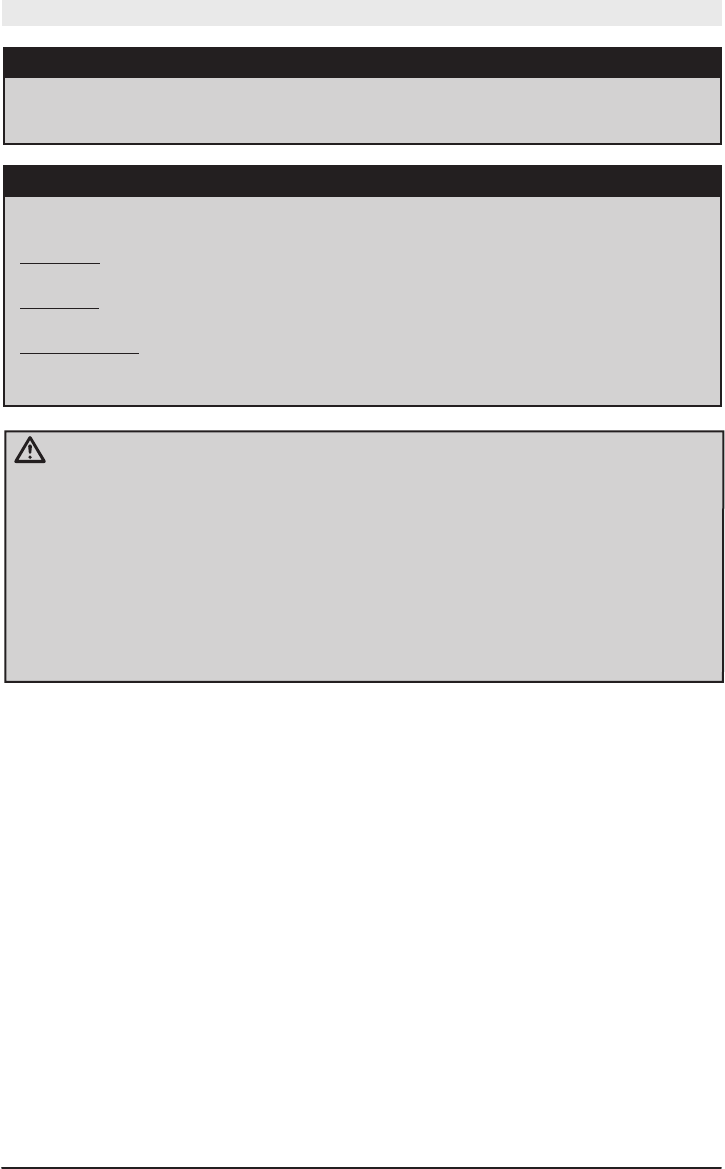
FR
14
AVERTISSEMENT : lisez la TOTALITÉ du manuel d’utilisation an de vous familiariser avec les
caractéristiques du produit avant de le faire fonctionner. Une utilisation incorrecte du produit peut
entraîner sa détérioration, ainsi que des risques de dégâts matériels, voire de blessures graves.
Ceci est un produit de loisirs sophistiqué. Il doit être manipulé avec prudence et bon sens et requiert
des aptitudes de base en mécanique. Toute utilisation irresponsable ne respectant pas les principes de
sécurité peut provoquer des blessures, entraîner des dégâts matériels et endommager le produit. Ce
produit n’est pas destiné à être utilisé par des enfants sans la surveillance directe d’un adulte. N’essayez
pas de modier ou d’utiliser ce produit avec des composants incompatibles hors des instructions fournies
par Horizon Hobby, LLC. Ce manuel comporte des instructions relatives à la sécurité, au fonctionnement et
à l’entretien. Il est capital de lire et de respecter la totalité des instructions et avertissements du manuel
avant l’assemblage, le réglage et l’utilisation, ceci an de manipuler correctement l’appareil et d’éviter
tout dégât matériel ou toute blessure grave.
14 ans et plus. Ceci n’est pas un jouet.
Précautions et avertissements
liés à la sécurité
• Conservez toujours une distance de sécurité tout
autour du modèle an d’éviter les collisions ou
risques de blessures. Ce modèle est contrôlé
par un signal radio, qui peut être soumis à des
interférences provenant de nombreuses sources
que vous ne maîtrisez pas. Les interférences sont
susceptibles d’entraîner une perte de contrôle
momentanée.
• Faites toujours fonctionner votre modèle dans
des espaces dégagés, à l’écart des véhicules, de
la circulation et des personnes.
• Respectez toujours scrupuleusement les
instructions et avertissements relatifs à
votre modèle et à tous les équipements
complémentaires optionnels utilisés (chargeurs,
packs de batteries rechargeables, etc.).
• Tenez toujours tous les produits chimiques, les
petites pièces et les composants électriques hors
de portée des enfants.
• Évitez toujours d’exposer à l’eau tout équipement
non conçu et protégé à cet effet. L’humidité
endommage les composants électroniques.
• Ne mettez jamais aucune partie du modèle dans
votre bouche. Vous vous exposeriez à un risque
de blessure grave, voire mortelle.
• Ne faites jamais fonctionner votre modèle lorsque
les batteries de l’émetteur sont faibles.
• Gardez toujours votre modèle à vue an d’en
garder le contrôle.
• Utilisez toujours des batteries totalement
chargées.
• Laissez toujours l’émetteur sous tension tant que
la batterie du modèle est branchée.
• Débranchez toujours la batterie avant de
désassembler le modèle.
• Nettoyez toujours les parties mobiles.
• Gardez toujours le modèle à l’écart de l’humidité.
• Laissez toujours refroidir avant de manipuler.
• Débranchez toujours la batterie après utilisation.
• Débranchez toujours que le failsafe est
correctement réglé avant d’effectuer un vol.
• N’utilisez jamais l’avion si le câblage est
endommagé.
• Ne touchez jamais les parties mobiles.
Signification de certains termes spécifiques :
Les termes suivants sont utilisés dans l’ensemble du manuel pour indiquer différents niveaux de danger
lors de l’utilisation de ce produit :
REMARQUE : procédures qui, si elles ne sont pas suivies correctement, peuvent entraîner des dégâts
matériels ET éventuellement un faible risque de blessures.
ATTENTION : procédures qui, si elles ne sont pas suivies correctement, peuvent entraîner des dégâts
matériels ET des blessures graves.
AVERTISSEMENT : procédures qui, si elles ne sont pas suivies correctement, peuvent entraîner des
dégâts matériels et des blessures graves OU engendrer une probabilité élevée de blessure supercielle.
REMARQUE
La totalité des instructions, garanties et autres documents est sujette à modication à la seule
discrétion d’Horizon Hobby, LLC. Pour obtenir la documentation à jour, rendez-vous sur le site
www.horizonhobby.com et cliquez sur l’onglet de support de ce produit.
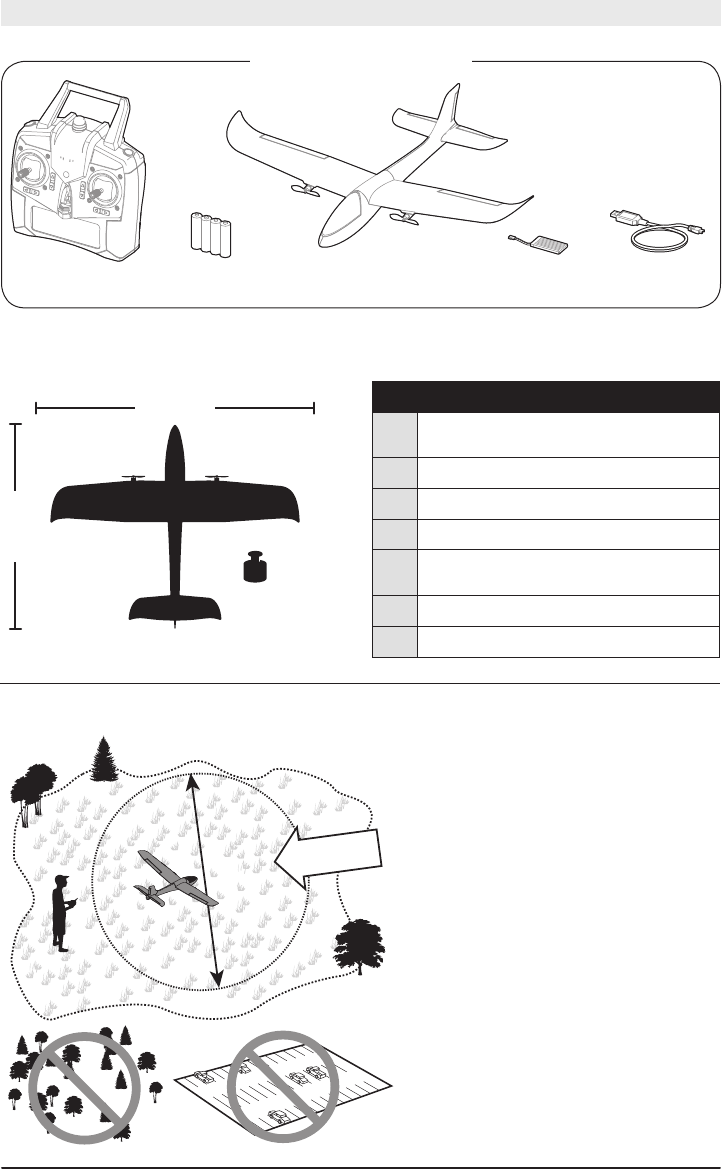
FR
15
Ascent MTxÉmetteur Batterie au lithium-
polymère 300mAh 3,7V Chargeur USBPiles alcalines
AA (4)
Inclus dans la boîte Pour enregistrer votre produit
en ligne, rendez-vous sur www.
horizonhobby.com
Volez dans cette zone
(pilote face au vent)
Tenez-vous ici
300 pieds
(91 m)
Vent 0–8 km/h
Conseils de vol
395mm
483mm
47 g
• Consultez les réglementations locales avant
de choisir un lieu pour effectuer le vol.
• Effectuez les vols en extérieur, par vent faible
uniquement.
• Les vols en intérieur se font dans un grand
gymnase.
• Toujours garder votre avion à vue et à une
altitude sufsante. Ne pas dépasser une
distance de 91m qui correspond à la portée
radio. En cas de perte de connexion, les
moteurs s’éteindront et l’avion descendra.
Laissez votre émetteur sous tension et
rapprochez-vous de vote avion pour en
reprendre le contrôle.
• Toujours voler à l’écart des maisons, des
arbres, des lignes électriques et autres
constructions.
• Toujours voler à l’écart des zones fréquentées
comme les parcs, les cours d’écoles ou les
terrains de sport.
1. Trouvez une zone sûre et bien
dégagée.
2. Chargez la batterie.
3. Installez la batterie dans l’avion.
4. Effectuez un test des commandes.
5. Planiez votre vol en fonction des
conditions du terrain.
6. Réglez le chronomètre sur 10 minutes.
7. Amusez-vous!
Specifications Checklist d’avant vol
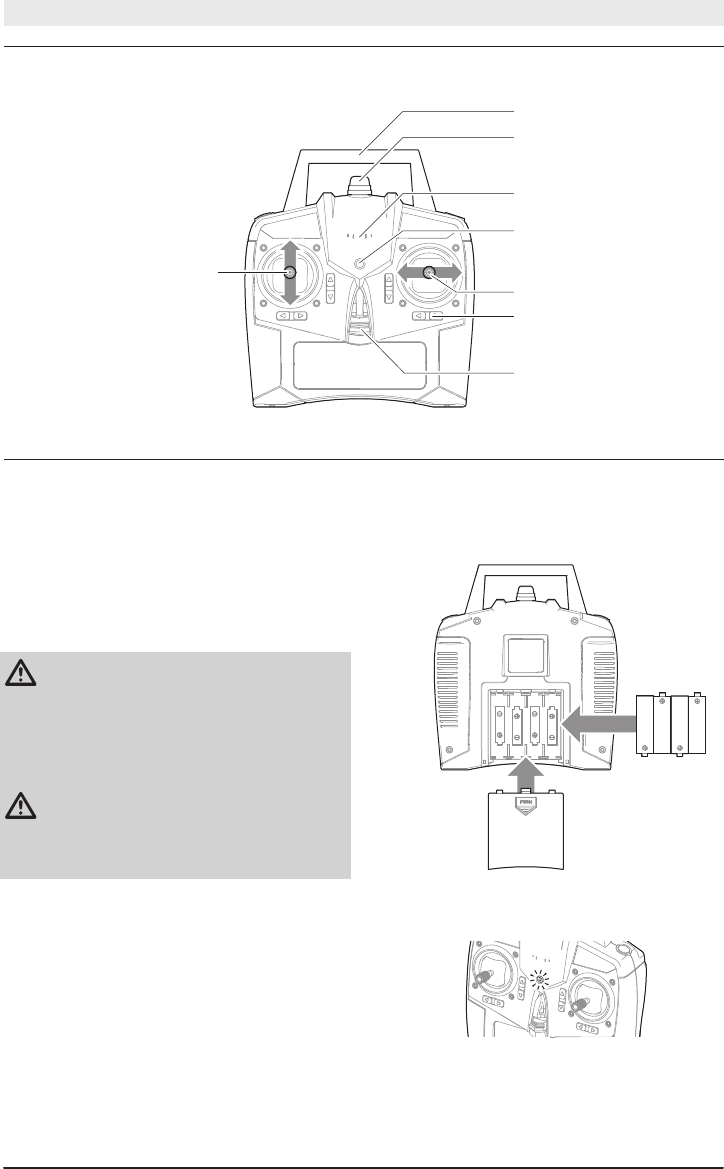
FR
16
Retirez le couvercle des piles, installez les quatre
piles AA incluses (en faisant attention à la polarité)
et remettez le couvercle des piles.
Émetteur
Alarme de batterie faible
Lorsque la tension des piles de l’émetteur est
trop faible, une alarme se fait entendre et la
DEL clignote. Les piles doivent être remplacées
immédiatement. Si cela se produit en vol, posez
votre aéronef dès que possible en toute sécurité.
Installation des piles de l’émetteur
A
H
G
F
E
D
B
C
A : Gaz
B : Poignée
C : Antenne
D : Haut-parleur
E : DEL
F : Direction
G : Compensateur de
direction
H : Interrupteur
ATTENTION: Si vous utilisez des piles
rechargeables, ne rechargez que les piles
rechargeables. Tenter de recharger des piles non
rechargeables peut provoquer une explosion,
entraînant des blessures corporelles et/ou des
dégâts matériels.
ATTENTION: Risque d'explosion si le type
de piles insérées n’est pas correct. Jetez les
piles usées conformément aux réglementations
locales.
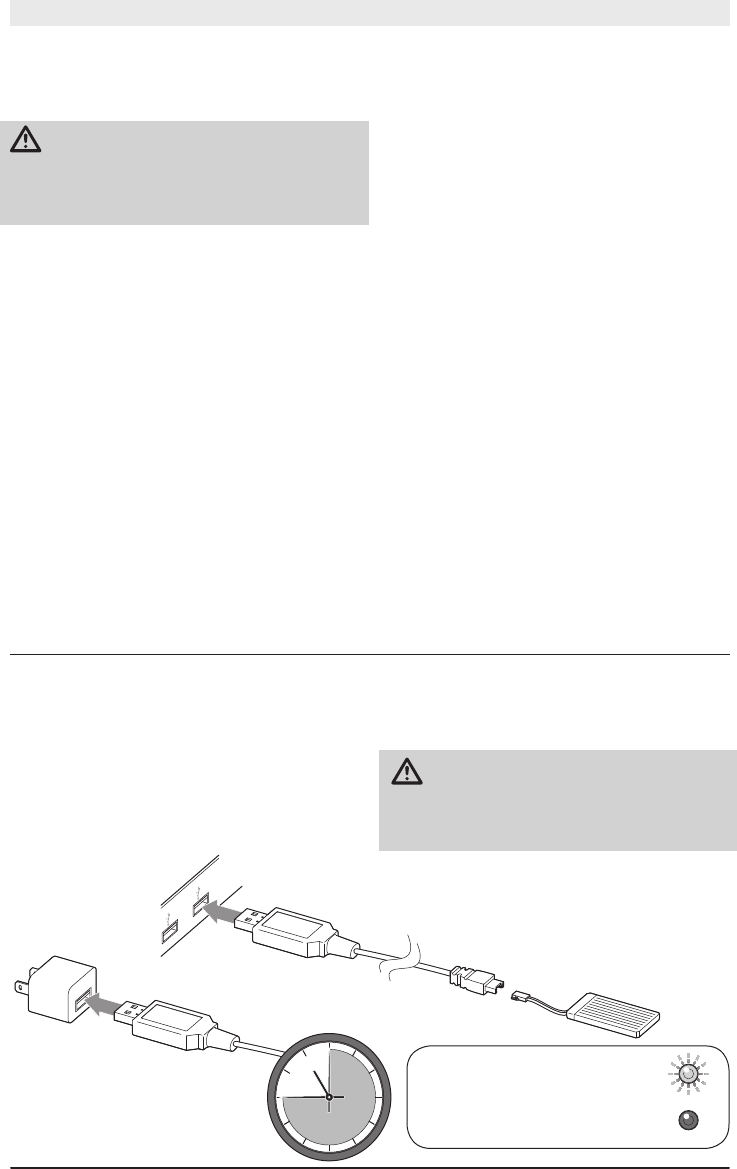
FR
17
Rechargez toujours la batterie de l’aéronef avant de
le faire voler.
ATTENTION: Ne rangez pas la batterie au
lithium-polymère dans le chargeur. Cela risque
d’entraîner une décharge excessive de la batterie
au lithium-polymère.
Recharge de la batterie de vol
1. Raccordez la batterie au lithium-polymère au
charger USB inclus.
2. Raccordez le chargeur USB à un adaptateur de
charge USB pour téléphone (non inclus) ou à un
port USB sous tension.
3. La DEL sur le chargeur brillera d’un rouge
xe pendant la charge et s’éteindra lorsque la
batterie sera entièrement chargée.
EN CHARGE (Rouge xe) .....................
CHARGE MAXIMALE (éteinte) .............
45
MIN.
L’émetteur livré avec le Duet a été développé an de
charger la batterie Li-Po de façon sûre.
ATTENTION: Toutes les instructions et mises en
garde doivent être scrupuleusement suivies. Une
mauvaise utilisation des batteries Li-Po peut produire
un incendie, des dommages aux personnes ainsi
qu’aux biens.
• Manipuler, charger ou utiliser la batterie Li-Po
incluse indique que vous assumez les risques liés
à l’utilisation de batteries au Lithium.
• Si à quelque moment que ce soit, la batterie
commence à goner ou suinter, arrêter l’utilisation
immédiatement. Si en charge ou en décharge,
cessez immédiatement et déconnectez la batterie.
Continuer à utiliser, charger ou décharger une
batterie gonée, ou suintante peut provoquer un
incendie.
• Pour obtenir les meilleurs résultats, entreposez
toujours la batterie à température ambiante, dans
un endroit sec.
• Lorsque vous transportez la batterie ou que vous
la stockez temporairement, la température doit
toujours être comprise entre 5 et 49 ºC.
• Ne stockez en aucun cas la batterie ou
l’hélicoptère dans une voiture ou à un endroit
directement exposé à la lumière du soleil. Laissée
dans une voiture chaude, la batterie peut se
détériorer ou même prendre feu.
• Chargez toujours les batteries à distance de tout
matériau inammable.
• Faites toujours l’inspection de la batterie avant la
charge, et ne chargez jamais des batteries hors
d’usage ou endommagées.
• Déconnectez toujours la batterie après la charge,
et laissez le chargeur refroidir entre les charges.
• Surveillez toujours en continu la température du
pack de batteries au cours de la charge.
• UTILISEZ EXCLUSIVEMENT UN CHARGEUR CONÇU
SPÉCIFIQUEMENT POUR CHARGER DES BATTERIES
LI-PO. Le fait de charger la batterie avec un
chargeur non compatible peut être à l’origine d’un
incendie provoquant des blessures corporelles et/
ou des dégâts matériels.
• Ne déchargez jamais les cellules Li-Po en dessous
de 3 V.
• Ne couvrez jamais les étiquettes d’avertissement
avec des bandes auto-agrippantes.
• Ne laissez jamais sans surveillance des batteries
en cours de charge.
• Ne chargez jamais les batteries sans respecter les
niveaux recommandés.
• N’essayez jamais de démonter ou de modier le
chargeur.
• Ne laissez jamais des mineurs charger des packs
de batteries.
• Ne chargez jamais les batteries dans des endroits
extrêmement chauds ou froids (la plage de tem-
pératures recommandées se situe entre 5 et 49
°C) et ne les exposez jamais à la lumière directe
du soleil.
Avertissements relatifs à la batterie
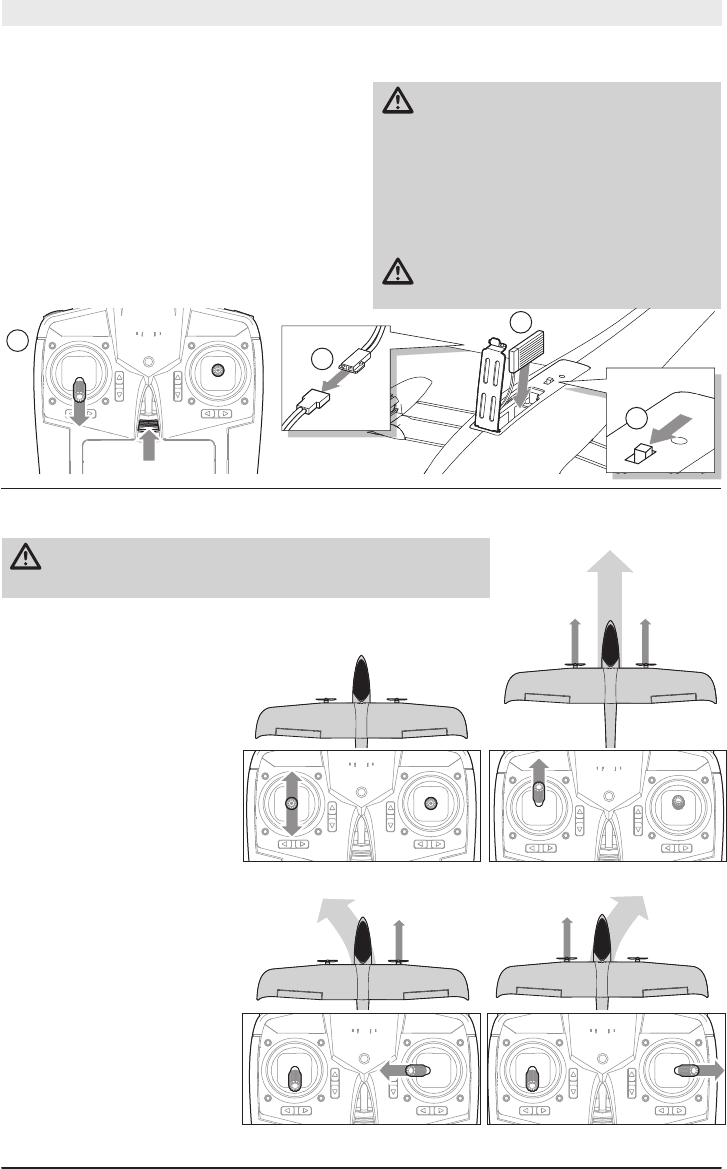
FR
18
Installation de la batterie de vol
1. Assurez-vous que la commande des gaz est en
position éteinte et allumez l’émetteur.
2. Ouvrez le compartiment de batterie au bas de
l’aéronef et branchez-y la batterie de vol.
3. Installez la batterie de vol dans l’aéronef comme
indiqué et refermez la trappe.
4. Allumez l’aéronef.
Test des commandes
3
4
2
1
ATTENTION: Débranchez toujours la
batterie de vol de l’aéronef lorsque vous ne le
faites pas voler pour éviter toute décharge
excessive de la batterie. Une batterie déchargée
à une tension inférieure à la plus basse tension
approuvée peut s’endommager, entraînant une
perte de performance et un risque d’incendie
lorsque la batterie est rechargée.
ATTENTION: Ne vous approchez pas des
hélices.
Armez les moteurs
Faites tourner les moteurs de
gauche et de droite
Plein régime (100%)
Faites tourner les moteurs de droite
et de gauche
1. Allumez l’aéronef comme
indiqué ci-dessus.
2. Allumez l’émetteur.
3. Tenez l’aéronef an qu’il
n’échappe pas à votre contrôle.
4. Armez les moteurs en
commençant par mettre le
levier de gauche sur 100%,
puis en le ramenant à 0%.
5. Bougez les leviers sur
l’émetteur pour vous assurer
que les moteurs répondent
comme indiqué.
Astuce: Pour vérier la direction
à gauche et à droite, maintenez
la commande des gaz à 0% et
notez quel moteur tourne.
Si les moteurs ne réagissent pas
comme indiqué, consultez les
consignes d’affectation et le guide
de dépannage dans ce manuel.
ATTENTION: Ne vous approchez pas des hélices, elles vont
tourner lors du test des commandes.
L’aéronef Ascent™ MTx utilise la poussée du moteur pour monter,
descendre et tourner. Effectuez toujours un test des commandes avant
le vol pour vous assurer que les moteurs fonctionnent correctement.